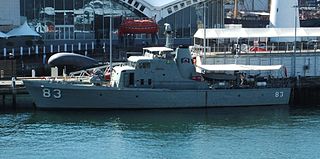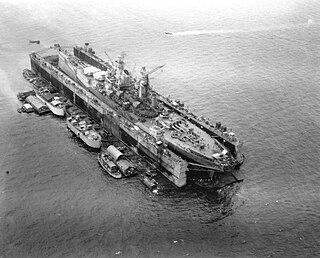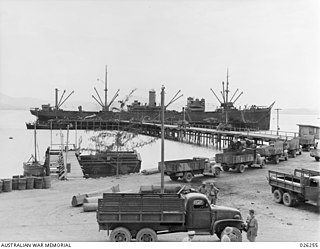
The Papua New Guinea Defence Force (PNGDF) is the military organisation responsible for the defence of Papua New Guinea. It originated from the Australian Army land forces of the territory of Papua New Guinea before independence, coming into being in January 1973 and having its antecedents in the Pacific Islands Regiment. The PNGDF is a small force, numbering around 3,600 personnel, and consists of a Land Element, an Air Element and a Maritime Element. It is a joint force tasked with defending Papua New Guinea and its territories against external attack, as well as having secondary functions including national-building and internal security tasks.

Manus Island is part of Manus Province in northern Papua New Guinea and is the largest of the Admiralty Islands. It is the fifth-largest island in Papua New Guinea, with an area of 2,100 km2 (810 sq mi), measuring around 100 km × 30 km. Manus Island is covered in rugged jungles which can be broadly described as lowland tropical rain forest. The highest point on Manus Island is Mt. Dremsel, 718 metres (2,356 ft) above sea level at the centre of the south coast. Manus Island is volcanic in origin and probably broke through the ocean's surface in the late Miocene, 8 to 10 million years ago. The substrate of the island is either directly volcanic or from uplifted coral limestone.

HMAS Aitape was an Attack-class patrol boat of the Royal Australian Navy (RAN). It was named for the small town of Aitape, Sandaun Province, Papua New Guinea. Completed in 1967, the vessel was one of five assigned to the RAN's Papua New Guinea (PNG) Division. The patrol boat was transferred to the Papua New Guinea Defence Force in 1974 as HMPNGS Aitape. She remained active until 1982, when she was removed from service for use as a parts hulk. Aitape was scuttled off Port Moresby for use as a dive wreck in 1995.

HMPNGS Lakekamu is Balikpapan-class landing craft heavy (LCH) operated by the Maritime Operations Element of the Papua New Guinea Defence Force (PNGDF). The vessel was one of eight built for the Royal Australian Navy (RAN) in the 1970s, and was commissioned into the RAN as HMAS Labuan in March 1973. Labuan was decommissioned in November 2014. She was transferred to the PNGDF for use as a training ship and was commissioned as HMPNGS Lakekamu in December 2014.

HMAS Ladava was an Attack-class patrol boat of the Royal Australian Navy (RAN). It was named after the small village of Ladava situated on the shore of Milne Bay in Alotau District, Papua New Guinea. Completed in 1968, the vessel was one of five assigned to the RAN's Papua New Guinea (PNG) Division. The patrol boat was transferred to the Papua New Guinea Defence Force in 1974 as HMPNGS Ladava. The patrol boat was decommissioned in 1988, although her fate is unknown.

HMAS Madang, named for the settlement of Madang in New Guinea, was an Attack-class patrol boat of the Royal Australian Navy (RAN). Completed in 1968, the vessel was one of five assigned to the RAN's Papua New Guinea (PNG) Division. The patrol boat was transferred to the Papua New Guinea Defence Force in 1974 as HMPNGS Madang. She was decommissioned in 1989.

Seeadler Harbor, also known as Port Seeadler, is located on Manus Island, Admiralty Islands, Papua New Guinea and played an important role in World War II. In German, "Seeadler" means sea eagle, pointing to German colonial activity between 1884 and 1919 in that area. The bay was named in 1900 after the German cruiser SMS Seeadler.

Lorengau is the major town in Manus Province, Papua New Guinea. The town is located on the edge of Seeadler Harbour on Manus Island, in the Admiralty Islands, and in 2000 Lorengau was recorded to have a population of 5,829.

HMPNGS Seeadler (P03) is one of four Pacific Forum patrol vessels operated by the Papua New-Guinea Defence Force.

HMPNGS Ted Diro (P401) is the first Guardian-class patrol boat to be completed. Australia designed and provided four Pacific Forum-class patrol vessels to Papua New Guinea in 1987 and 1988, and in 2015 confirmed she would be replacing those vessels with four larger, and more capable, Guardian-class vessels.
HMPNGS Rabaul (01) was the first Pacific Forum patrol vessel to be commissioned, in May 1987. She is not the first vessel of the class to go out of service, because her sister ship from Fiji RFNS Kiro was wrecked in 2016. She arrived in Port Moresby, for disposal, on October 24, 2018. The vessel was named HMPNGS Tarangau.

USS ABSD-2, later redesignated as AFDB-2, was a ten-section, non-self-propelled, large auxiliary floating drydock of the US Navy. Advance Base Sectional Dock-2 was constructed in sections during 1942 and 1943 by the Mare Island Naval Shipyard in Vallejo, California for World War II. Her official commissioning ceremony took place on 14 August 1943 with CDR. Joseph J. Rochefort in command. With all ten sections joined, she was 927 feet long, 28 feet tall, and with an inside clear width of 133 feet 7 inches. ABSD-2 had a traveling 15-ton capacity crane with an 85-foot radius and two or more support barges. The two side walls were folded down under tow to reduce wind resistance and lower the center of gravity. ABSD-2 had 6 capstans for pulling, each rated at 24,000 lbf (110,000 N) at 30 ft/min (0.15 m/s), 4 of the capstans were reversible. There were also 12 ballast compartments in each section.

USS ABSD-4, later redesignated as AFDB-4, was a nine-section, non-self-propelled, large auxiliary floating drydock of the US Navy. Advance Base Sectional Dock-4 was constructed in sections during 1942 and 1943 by the Mare Island Naval Shipyard in Vallejo, California for World War II. With all ten sections joined, she was 927 feet long, 28 feet tall, and with an inside clear width of 133 feet 7 inches. ABSD-4 had a traveling 15-ton capacity crane with an 85-foot radius and two or more support barges. The two side walls were folded down under tow to reduce wind resistance and lower the center of gravity. ABSD-4 had 6 capstans for pulling, each rated at 24,000 lbf (110,000 N) at 30 ft/min (0.15 m/s), 4 of the capstans were reversible. There were also 4 ballast compartments in each section.

Naval Advance Base Espiritu Santo or Naval Base Espiritu Santo, most often just called Espiritu Santo, was a major advance Naval base that the U.S. Navy Seabees built during World War II to support the Allied effort in the Pacific. The base was located on the island of Espiritu Santo in the New Hebrides, now Vanuatu, in the South Pacific. The base also supported the U.S. Army and Army Air Corps, U.S. Coast Guard, and US Marine Corps. It was the first large advance base built in the Pacific. By the end of the war it had become the second-largest base in the theater. To keep ships tactically available there was a demand for bases that could repair and resupply the fleet at advance locations, rather than return them to the United States. Prior to December 7th, Pearl Harbor was the U.S. fleet's largest advance base in the Pacific. Espiritu became capable of all aspects necessary to support the Fleet's operations from fleet logistics in fuel, food, and ammunition, to transport embarkation for combat operations or returning to the continental United States. The ship repair facilities and drydocks were capable of attending to most damage and routine maintenance. Had it not existed, ships would have had to return to Pearl Harbor, Brisbane, or Sydney for major repairs and resupply. The base became a major R and R destination for the fleet.

US Naval Advance Bases were built globally by the United States Navy during World War II to support and project U.S. naval operations worldwide. A few were built on Allied soil, but most were captured enemy facilities or completely new. Advance bases provided the fleet with support to keep ships tactically available with repair and supply depots of facilities, rather than return them to the continental United States. Before Japan declared war on the United States the U.S. Navy had a single fleet-sized advanced base in the Territory of Hawaii at Naval Station Pearl Harbor. During the war the U.S. Navy Seabees built over 400 advance bases categorized by size. Naval bases were either Lions or Cubs while airfields were either Oaks or Acorns. Lions and Oaks were major facilities while Cubs and Acorns were minor. PT Boats typically would get a Cub and airfields with single runways were Acorns. The larger bases could do refueling and overhaul; loading of troopship and cargo ships; and preparing amphibious assault ships. Some became major repair depots. The Seabees developed auxiliary floating drydocks were able to repair battle damage and do regular maintenance in the field saving ships trans-pacific trips for repair. A few bases also were developed to be R and R for all U.S. personnel. Most Advance Bases were built by the US Navy's Seabees in Naval Construction Battalions (CBs). At the start of the war civilian contractors were employed in construction. The Seabees in World War II built most of the airfields used by the United States Army Air Forces and United States Marine Corps, as they had the ships and cranes needed to transport the vast amount of equipment needed at the advance bases. The US Army and United States Coast Guard also operated out of many of these facilities. Seabees could build new or repair damaged runways, and with advancements in heavy bomber technology lengthen runways as needed. A few Naval Advance Bases were built for the Korean War and Vietnam War.

Naval Base Milne Bay, also called Naval Advance Base Milne Bay, was new major United States Navy sea and airbase base built on Milne Bay in Milne Bay Province in south-eastern Papua New Guinea. By spring 1943, the build up of the US Navy to support the Pacific War had caused overcrowding at the ports on the east coast of Australia. To help, Seabees departed Naval Base Brisbane on June 19, 1943 to set up a new base in Milne Bay. Naval Base Milne Bay headquarters was at Ladava Navy Base. The Royal Australian Navy already had a small base in Milne Bay: HMAS Ladava. Australians were able to defend and keep Milne Bay in the Battle of Milne Bay in 1942. Naval Base Milne Bay was built during World War II to support the many ships and aircraft fighting and patrolling in the South West Pacific theatre of war. Ladava Navy Base provided a large protective US Navy fleet anchorage at Gahora Bay next to Ladava. At Naval Base Milne Bay, Seabees built a large Naval facility.

Manus Naval Base was a number of bases built after the World War II Battle of Manus by United States Navy on the Manus Island and a smaller island just east, Los Negros Island in the Admiralty Islands chain. The major naval base construction started with the Los Negros landings on February 28, 1944. The Navy repaired and did the expansion of the airfields on the Admiralty Islands. United States Navy Seabee built or repaired the facilities on the islands. The large Manus Naval Base, also called the Admiralty Island base, supported United States Seventh Fleet, Southwest Pacific command, and part of the Pacific Fleet. The base was abandoned by the US Navy after the war.

Naval Base Brisbane was a major United States Navy base built in the early part of World War II at Brisbane, Queensland, Australia. At first, operated as a base for patrol aircraft and convoy escort aircraft to protect the last leg of the Pacific War to the Southwest Pacific. As the US Navy expanded in the island hopping campaign, Naval Base Brisbane expanded to include a submarine base, repair depot, seaplane base and other facilities. US Navy operations started on April 14, 1942, and ended after the war in 1945.

Naval Base Port Moresby was a United States Navy base built during World War II at the city of Port Moresby on Papua New Guinea. The US Navy built a communication center and advance base headquarters for the US Seventh Fleet to support the Pacific War in 1943. The base was part of the New Guinea campaign.

Naval Base Alexishafen was a United States Navy base built during World War II at Alexishafen, north of the city of Madang in New Guinea. The base was built by the US Navy Seabees starting June 13, 1944 as part of the New Guinea campaign of the Pacific War. The base was built at the request of the Seventh Amphibious Force of the United States Seventh Fleet to support the many boats patrolling the area. The US Navy built a boat repair depot including Auxiliary floating drydocks. The base was closed in January 28, 1945.



































